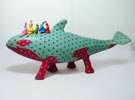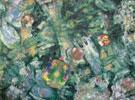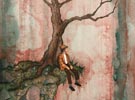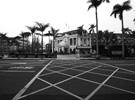十四
他顺着自己的发展轨迹-从学院派现实主义、文人美学,到20世纪藉着印刷、媒体、各种信息传播和社会变迁渠道而转型的民间图像-形成了他的绘画视觉语言。这套视觉语言不归属任何一种现存的造型模式,既非高雅,亦非通俗艺术。画家冒险贴近媚俗路线,以求有效颠覆它。结果他独树一格的图像,取得了非凡的情感和批判强度,使赏画者内心欲迎还拒,欲拒还迎。这种状态称之为难以承受,最为贴切。这样的感受,实为当代社会现实中无所不在的。
For Feng however, in working through the trajectories of academic realism, literati aesthetics and the 20th century transformations of folk imagery through the channels of social dissemination and changes in print media, he crystallizes a painted visual language which may not be categorized in any of the prevailing mode of image making. This new painted language is of neither high nor popular art. Yet it takes a personal risk in getting very close to kitsch so as to effectively subvert it, yielding a powerful emotive and critical intensity through his unique images with the kind of push and pull in a viewer which can be best described as an activity that is unbearable. And this is a feeling that is omnipresent in the realities of contemporary society.
——郭建超:《俸正杰:〈本色〉》(2007年)
Guo Jianchao, Feng Zhengjie: Primary Colours, 2007
十五
俸正杰的这些“中国肖像”系列,恰好是反肖像画传统的。在他这里,肖像画表达了肖像画的不可能。他不厌其烦地画了如此之多的面孔,但是,这所有的面孔,都没有深入面孔后面的内心,我们甚至可以说,所有的面孔,都是故意地拒绝内心的,都是故意地对肖像画的“表现”传统进行毁灭的……
The Chinese Portrait series by Feng Zhengjie exactly stand contrary to the tradition of portrait painting. In his composition, what a portrait can convey is the impossibility of painting portrait. He has taken great pains to produce so many faces, but none of them can lead the viewer deep into the figures’ inner hearts. We might even conclude that all of the faces deliberately refuse to expose the innermost and intend to destroy the “expressive” tradition of portrait…
俸正杰的这些肖像,是一张脸,但不像是一个独特身体的脸,不是一个有生命力的脸,它是一个剔除了激情和血肉的脸。或许,在中国当代艺术家中,俸正杰是最彻底地拒绝肉的人。从这个意义上而言,俸正杰走在同肖像画传统相反的方向上――他的这类肖像,就是要根除人的激情,就是要根除脸后面的身体和生命,就是要根除人的独一无二的个性,从根本上来说,就是要让人不存在,就是要消灭人,就是要将一个肖像成为非肖像,就是让肖像画成为对肖像画的反动。
The portrait work produced by Feng Zhengjie is nothing but a face, a face with passion, blood, and flesh rid rather than a face in a specific body or a lively face. Perhaps, among the contemporary Chinese artists, Feng Zhengjie is one who has most radically refused flesh. In this sense, Feng Zhengjie is on the way opposite to the tradition of portrait. The final aim of his creation pattern is to exterminate human passion, to exterminate the body and life beneath face, to exterminate human singular personality. In effect, it will lead to the nonexistence of man, to the extermination of man, and to such a consequence that a portrait appears as a non-portrait and portrait stands as anti-portrait.
——汪民安:《没有肉的脸》(2007年)
Wang Min’an, The Face without Flesh, 2007
十六
头骨总是能立即直观地传递出死亡的讯息。然而随着人的头部从健康美丽的生物体中生长出来,这也意味着一个神圣的再生,同样,我们生来拥有骸骨,辞世后唯一能留下的也只有这具骸骨。因此这也赋予了这件装置更深远的意义。
It is simply easy to identify the appearance of the skull immediately to symbolize as something deathly. Yet, with the heads growing out of these healthy, living organism, there also connotes a divine rebirth as we are all born with an skeletal anatomy as much as that remains the only part of us when we part from this earth. Hence, the further significance of the title of this installation.
这件装置的后面展开的是“生命金字塔”, 三个以砖块制成的金字塔造型,砖块分别印上了女性、玫瑰和头骨的形象。这些对称三角金字塔的顶部是它们三维的形象,这些形象缓慢而持续地旋转着,仿佛我们在展览中徘徊时记录着时间缓缓的流逝。多层装置的肖像强烈唤起了那些在自我意识周边环绕的事物。金字塔代表了永恒的时间,俸正杰再一次强调了美好事物和人类青春的短暂。
Deployed just behind this installation is The Pyramid of Life, three pyramid-like formations built with bricks which, in turn, are imprinted with images of a woman, a rose and a skull respectively. And on top of these symmetrical triangles are three-dimensional versions of the imprints which also rotate consistently on a snail’s pace as if to record the passage of time slowly drifting always as we linger around the exhibition. The imagery caused by this multitiered installation is also strongly evocative of something that hovers on the edge of self-consciousness. Pyramids stand for the eternity of time and once again, Feng inhabits the structures with the temporality of beauty and youth.
右边的角落里安置着名为“升”的作品,这是一个旋转的装置,一圈悬挂着的轻巧的十字架形状的人像不断周而往复地转动,寓意着生与死的轮回,这些造型单纯的人像上涂有粉红、绿和金黄色,看似漂浮的雕像就像没有肉的骨骼一般代表了空虚、极简和纯粹这样一些美学上的本质。同时它也暗示了无论人的信仰如何,总会在某时某地真切地感受到生与死是如此紧密地和信仰的精神层面相连,因为宗教意识已然经深深地融入我们的日常意识。
Right at a corner lays Ascend, a spiraling installation that introduces an ethereal quality trailing off from a circle of hanged cross-like figures into a repetitive motion that seems to suggest the recurring cycle of life and death are bound together. With these simplified figures toned in vibrant pink, green and gold, the deceptively floating sculptures have the rhythmic energy of seamlessness, minimal and purity which is integral to the bare-bones aesthetic. Yet it also hinted at a place and time how we always think of birth and death as closely related to the spiritual iconographies of religion that has seeped into our daily consciousness regardless we are believers of faith or not.
这些雕塑装置每一个都可单独摆放自成一体,亦可组合在一起相互辉映,它们的存在让画廊中充满了朦胧的清冷感和一丝丝难以言喻的预感。死亡、生存、美丽在这些作品中交缠,将时空相隔。
Each of these sculptural installations, which collectively reinforce one another even as they successfully stood alone, filled the gallery with chilling haziness and premonitions. Death, birth and beauty intertwine in these works, as do disparate places and times.
——吴承祖:《如在其上,似在其下》(2008年)
Josef Ng,As Above, So Below,2008
十七
俸正杰的标志性绘画——那些年轻女性的硕大、扁平的特写镜头,她们皮肤光滑、发型无懈可击,被渲染以怪诞的绿色和粉红色调——是中国当代艺术的恶之花之一。怀疑论者会断言,这些风行一时的图像从智性角度来说不值一提,然而,几乎没有人能忍住对它们一眼不瞟。这些构图既浩渺又强烈,面部的特征如此迷人 ,双眼目光如炬,那种抵制似乎是徒劳的。这就是艺术家在概念上的绝技。引发了观看者的那种无意识反应,揭示了那种集体性的虚假,其本身就足以让公正的观察家认识到俸正杰的机敏和狡黠,足以使他获得被评价的资格。不过,事实上,这些绘画的意义远胜于仅仅吸引我们的眼球,远胜于跟我们的感知力玩障眼法。它们在很大程度上揭示了现代中国的具象艺术史,肖像画法的固有动力,以及今日全球文化中的一种视觉规则的普遍化。
The signature paintings of Feng Zhengjie—huge, flat close-ups of smooth-skinned and flawlessly coiffed young women, rendered in unearthly shades of green and pink—are one of the guilty pleasures of contemporary Chinese art. Skeptics will claim to intellectually disdain these high-fashion images, yet almost no one can resist looking at them. The compositional forms are at once so sweeping and strong, the facial features so alluring, the eyes so intensely fixed, that resistance seems futile. This is the artist’s conceptual coup. To have triggered that unwilled viewer response, to have uncovered that public hypocrisy, would in itself be enough to alert fair-minded observers to Feng’s dexterity and cunning, and to secure his critical standing. But in fact the pictures do much more than simply arrest our gaze, much more than play bait-and-switch with perceptions. In their very process of deception, they lay bare much about the history of figurative art in modern China, the innate dynamics of iconography, and the universalization of a visual code in today’s global culture.
──理查德·瓦因:《直面俸正杰》(2009年)
Richard Vine,Facing Up to FengZhengjie, 2009




